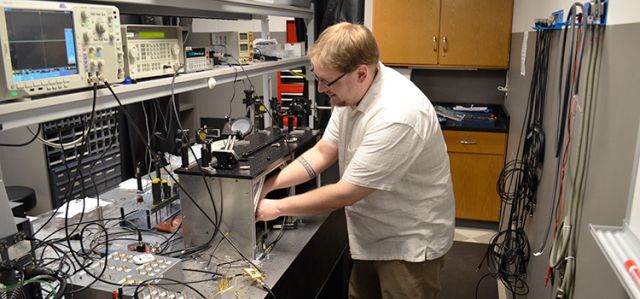Adaptive Laser Beam Projection on an Extended Target: Phase- and Field-conjugate Pre-compensation
Document Type
Article
Publication Date
7-1-2007
Publication Source
Journal of the Optical Society of America A
Abstract
The problem of adaptive laser beam projection onto an extended object (target) having a randomly rough surface in an optically inhomogeneous medium (atmosphere) is analyzed. Outgoing beam precompensation is considered through conjugation of either the target-return wave phase or the complex field. It is shown that in the presence of “frozen” turbulence, both phase-conjugate (PC) and field-conjugate (FC) precompensation can result in a superfocusing effect, which suggests the possibility of achieving a brighter target hit spot in volume turbulence than in vacuum. This superfocusing effect is significantly more distinct for FC precompensation. In the quasi-stationary case (slowly moving turbulence or target), PC and FC beam control lead to enhanced intensity fluctuations at the target surface associated with intermittent formation and disintegration of bright target hit spots that sporadically attach to the extended target surface. This intensity fluctuation level exceeds intensity fluctuations in the absence of beam control and is higher for FC precompensation. In the nonstationary case, both PC and FC lead to an increase of beam width and centroid wander at the extended target surface compared with conventional projection of a collimated or focused beam.
Inclusive pages
1975- 1993
ISBN/ISSN
1084-7529
Copyright
Copyright © 2007, Optical Society of America
Publisher
Optical Society of America
Volume
24
Issue
7
Peer Reviewed
yes
eCommons Citation
Vorontsov, Mikhail; Kolosov, V. V.; and Kohnle, Anton, "Adaptive Laser Beam Projection on an Extended Target: Phase- and Field-conjugate Pre-compensation" (2007). Electro-Optics and Photonics Faculty Publications. 100.
https://ecommons.udayton.edu/eop_fac_pub/100
COinS




Comments
© 2007 Optical Society of America. One print or electronic copy may be made for personal use only. Systematic reproduction and distribution, duplication of any material in this paper for a fee or for commercial purposes, or modifications of the content of this paper are prohibited.
Permission documentation on file.